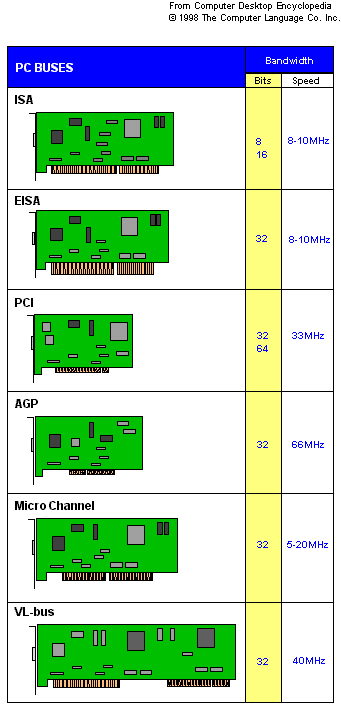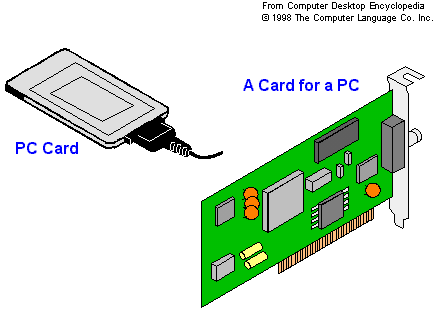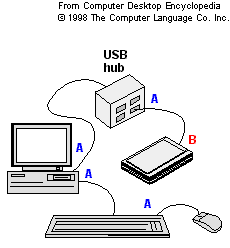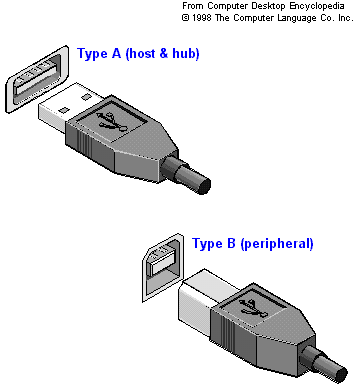
The computer's internal bus is known as the local bus, or processor bus. It provides a parallel data transfer path between the CPU and main memory and to the peripheral buses. Peripheral Buses are expansion boards (cards, adapters, etc.)that plug into the computer's bus. Signals and data pass between the peripheral device and memory. A 16-bit bus transfers two bytes at a time over 16 wires; a 32-bit bus uses 32 wires, etc. The bus is comprised of two parts: the address bus and the data bus. Addresses are sent over the address bus to signal a memory location, and the data is transferred over the data bus to that location. Various buses have been used in the PC, including the ISA, EISA, Micro Channel, VL-bus and PCI bus. Less common peripheral buses are NuBus, TURBOchannel, VMEbus, MULTIBUS and STD bus.
Popular Peripheral Buses:
Pronounced "eye-suh." An expansion bus commonly used in PCs. It accepts the plug-in boards that control the
video display, disks and other peripherals. Most PCs today use the ISA and PCI buses and have a combination of
ISA and PCI slots.
PCI
(Peripheral Component Interconnect)
PCMCIA or PC CARD
PCMCIA stands for Personal Computer Memory Card International Association An international standards body and trade association that was founded in 1989 to establish a standard for connecting peripherals to portable computers or LAPTOPS. The PC Card is a credit-card sized, removable module for portable computers standardized by PCMCIA. PC Cards are also known as "PCMCIA cards." PC Cards are 16-bit devices that are used to attach modems, network adapters, sound cards, radio transceivers, solid state disks and hard disks to a portable computer. The PC Card is a "plug and play" device, which is configured automatically by the Card Services software.All PC Cards are 85.6 mm long by 54 mm wide (3.37"x 2.126") and use a 68-pin connector.

The original Type I card is 3.3 mm thick and is typically used to hold memory.
Type II cards (5.0 mm thick) are commonly used for memory, modems and LAN adapters in laptops.
Type III cards (10.5 mm thick) are used to hold a hard disk, wireless transceiver or other peripheral that needs
more space.
The Type III slot can hold two Type II cards. Toshiba introduced a 16 mm Type IV card, but this has not been
officially adopted by the PCMCIA. Smaller cards will work in a Type IV slot.
CardBus
In early 1995, PCMCIA introduced the 32-bit CardBus standard. Although electrically different, the CardBus is
architecturally identical to the PCI bus. The CardBus supports bus mastering and accommodates cards operating at
different voltages. Its advanced power management features allows the computer to take advantage of CardBus cards
designed to idle or turn off in order to increase battery life. The CardBus specification allows data transfer up to
132 Mbytes/sec over a 33MHz, 32-bit data path.
Card and Socket Services
In order to use a PC Card slot in the computer, Card and Socket services must be loaded, typically at system startup.
Card and Socket Services software is generally included with laptops that have PC Card slots. It also comes packaged
with PC Cards. Card Services manage system resources required by the PC Card, and, on PCs, determines which IRQs and
memory and I/O addresses are assigned. They also manage hot swapping and pass changes in events to higher-level drivers
written for specific cards.
USB
(Universal Serial Bus) A hardware interface for low-speed peripherals such as the keyboard,
mouse, joystick, scanner, printer and telephony devices. It also supports MPEG-1 and MPEG-2 digital video. USB has a
maximum bandwidth of 1.5 Mbytes/sec, and up to 127 devices can be attached. Peripherals can be plugged in and unplugged
without turning the system off. USB ports began to appear on PCs in 1997, and Windows 98 fully supports it.
The devices are plugged directly into a four-pin USB socket on the PC or into a multi-port hub that plugs into the PC or
into a device that also functions as a hub for other devices. USB ports on the PC and hubs use a rectangular Type A socket.
All cables that are permanently attached to the device have a Type A plug.Devices that use a separate cable have a square
Type B socket, and the cable that connects them has both a Type A and a Type B plug.

USB Connections
The thin, rectangular A connectors are on the PC and hub.
Type B connectors are used on peripherals that have cables which are not permanently attached.

USB connections resolve IRQ conflicts, a common cause of installation problems.
Page4